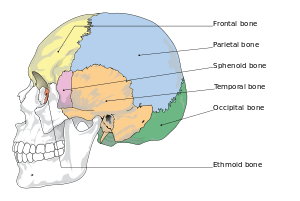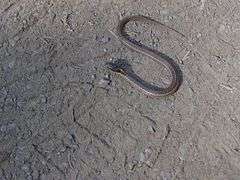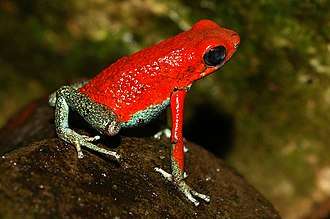Phenotypic integration
Phenotypic Integration occurs when multiple functionally-related traits are correlated with each other.[1] Complex phenotypes often require multiple traits working together in order to function properly. Phenotypic integration is significant because it provides an explanation as to how phenotypes are sustained by relationships between traits. Every organism's phenotype is integrated, organized, and a functional whole. Integration is also associated with functional modules. Modules are complex character units that are tightly associated, such as a flower.[2] It is hypothesized that organisms with high correlations between traits in a module have the most efficient functions.[3] The fitness of a particular value for one phenotypic trait frequently depends on the value of the other phenotypic traits, making it important for those traits evolve together. One trait can have a direct effect on fitness, and it has been shown that the correlations among traits can also change fitness, causing these correlations to be adaptive, rather than solely genetic.[4] Integration can be involved in multiple aspects of life, not just at the genetic level, but during development, or simply at a functional level. Integration can be caused by genetic, developmental, environmental, or physiological relationships among characters.[5] Environmental conditions can alter or cause integration, i.e. they may be plastic.[6] Correlational selection, a form of natural selection can also produce integration. At the genetic level, integration can be caused by pleiotropy, close linkage, or linkage disequilibrium among unlinked genes.[7] At the developmental level it can be due to cell-cell signaling such as in the development of the ectopic eyes in Drosophila. It is believed that the patterns of genetic covariance helped distinguish certain species.[8] It can create variation among certain phenotypes, and can facilitate efficiency. This is significant because integration may play a huge role in phenotypic evolution. Phenotypic integration and its evolution can not only create large amounts of variety among phenotypes which can cause variation among species. For example, the color patterns on Garter snakes range widely and are caused by the covariance among multiple phenotypes.

Origins
Shortly after the structure of DNA was uncovered, Olson and Miller (1958) wrote the first book regarding the topic of phenotypic integration.[9] The term integration was first used in reference to genetics by Olson and Miller, referring to correlations among characters that are influenced by selection.[10] Following Olson and Miller, botanical studies on coherence between characters were done spanning over many years.[11] Its first expansion was in the construction of a morphological integration genetic model constructed by Lande (1980). However, the term "Phenotypic Integration" was first coined by Pigliucci and Preston, in their book, Phenotypic Integration, which helped elucidate the observed laws of correlation and some theoretical issues regarding the topic.[12]
Natural Selection and Phenotypic Integration
Phenotypic Integration can be favorable or unfavorable with respect to natural selection. It has been shown that certain combinations of correlated traits can be unfavorable to an organism. In an ontogenetic study of laboratory rats, certain covariances among developmental characters which produced differing functions in the skull and limb were less favorable than another set that contributed to skull and limb structure.[13] The most common form of selection on phenotypic integration is correlational selection. Correlational selection is a form of natural selection that favors certain combinations of traits (phenotypic integration). It can promote both genetic correlations and high levels of genetic variation. It has even been found that correlational selection may be the most common form of natural selection.[14] Occasionally, this form of selection will favor a group of traits at the expense of others and if it does favor a particular set of traits it will include the most used traits whose functional effectiveness is essential for their ability to work together, and whose successful interaction is needed for the fitness of the individual.[15][16] Phenotypic integration may be the adaptive product of correlational selection. An example of natural selection favoring integration is in the color patterns and escape mechanisms of the Garter snake, Thamnophis Ordinoides.[17] Another example is in plants that have highly-specific pollinators, natural selection favors plants that have highly specialized flowering to pair with the specific pollinators, and therefore high floral integration.[18]

Evolution of Phenotypic Integration
Integration can be found at the genetic level due to gene linkage. Gene linkage involves multiple genes being inherited together during meiosis because they are close to each other on the same chromosome. Alleles at different loci can be inherited together if they are tightly linked. Large genetic correlations can only be upheld if the loci that influence different characters are tightly linked, or if high levels of inbreeding in the population occur. Even if selection favors the correlations, it will not be maintained unless those conditions are met. Selection will favor tight linkage because it is maintained better. Poorly linked genetic correlations will not last.[19] Transposition allows the loci at different locations on the chromosome to move so that they can become close to each other and be inherited together. This is significant to understanding the relationship between phenotypic integration and evolution because it is one of the mechanisms of how multiple traits that are connected to each other to evolve and change together. For instance, the Papilio dardanus butterflies come in three different forms, each mimicking a different distasteful butterfly species.[20] Multiple loci contribute to these different forms, and a butterfly with alleles for form A at one locus and B at another locus would have poor fitness. However, the multiple loci are tightly linked, so they are inherited together as a single allele. Through transposition, these multiple loci ended up close to each other.[21] Mutations among these linked genes are the nonadaptive fuel which can create evolution. Evolution may also occur because the integration may have an adaptive advantage in a particular environment for an organism. It is also important to recognize that not only can the traits be inherited together, but inherited separately and selected together. Another important example of phenotypic integration evolving over time is the relationship between the neurocranium and the brain. Over the last 150 million years the number of bones in the brain has decreased while the size of the brain in mammals has changed. Integration between the brain and the skull has evolved over this time period to reduce the number of bones in the cranium, while increasing the size of the brain. This relationship between correlated traits has played an important role in the evolution of mammalian cranium structure and brain size.[22] Finally, development is another crucial cause of phenotypic integration that has evolved over time. Cell-signaling pathways which utilize integration in the form of complex interactions among specific cells in the pathway are crucial to proper development in many organisms. The interactions among the cells in the pathway, and the interaction of the pathways with other pathways have evolved over time to create complex structures.[23]
Examples
Aposematism in poison frogs has also shown that phenotypic integration may be involved. Aposematism is the use of warning colors to deter predators because it often conveys the organism being poisonous, and this study found that diet specialization, and chemical defense are integrated and help affect aposematism.[24]

In another study regarding the relationship of sexual ornaments and phenotypic integration, there seems to be a paradox where sexual traits are expected to be both less integrated for greater expression, and more integrated to better indicate physiological quality. However, in the case of the house finch, the female house finches select for males based on their likelihood to be a good parent. The females base their choice of male parental behaviors on the elaboration of the male’s sexual ornamentation. Thus, female choice favors hormonally controlled integration of male sexual behaviors and male sexual ornamentation.[25]
Phylogenetically consistent patterns of phenotypic integration have also been recently reported in leaves, floral morphology, and dry fruits as well as in the morphology of some animal organs.[26][27]
Future work
Understanding phenotypic integration will continue as more research and understanding is done with regards to genetic, developmental, and physiological mechanisms, and learn more about the relationship of selection and complex phenotypes.[28] Research of this topic can even be beneficial to modern biomedicine.[29]
References
- Pigliucci, Massimo. "Phenotypic integration: studying the ecology and evolution of complex phenotypes." Ecology Letters 6.3 (2003): 265-272.
- Wagner, Günter P. "Homologues, natural kinds and the evolution of modularity." American Zoologist 36.1 (1996): 36-43.
- Brock, Marcus T., and Cynthia Weinig. "PLASTICITY AND ENVIRONMENT‐SPECIFIC COVARIANCES: AN INVESTIGATION OF FLORAL–VEGETATIVE AND WITHIN FLOWER CORRELATIONS." Evolution 61.12 (2007): 2913-2924.
- Schlichting, Carl D., and Massimo Pigliucci. Phenotypic evolution: a reaction norm perspective. Sinauer Associates Incorporated, 1998.
- Wagner, Gunter P., and Lee Altenberg. "Perspective: Complex adaptations and the evolution of evolvability." Evolution (1996): 967-976.
- Schlichting, Carl D. "The evolution of phenotypic plasticity in plants." Annual Review of Ecology and Systematics 17 (1986): 667-693.
- Murren, C. J., and P. X. Kover. "QTL mapping: a first step toward an understanding of molecular genetic mechanisms behind phenotypic complexity/integration." Phenotypic integration: studying the ecology and evolution of complex phenotypes (M. Pigliucci and K. Preston, eds.). Oxford University Press, New York (2004): 195-212.
- Murren, Courtney J., Nicole Pendleton, and Massimo Pigliucci. "Evolution of phenotypic integration in Brassica (Brassicaceae)." American Journal of Botany 89.4 (2002): 655-663.
- Olson E.C. & Miller R.L. (1958) Morphological Integration. University of Chicago Press, Chicago.
- Olson, Everett C., and Robert L. Miller. Morphological integration. University of Chicago Press, 1999.
- Clausen, J. & Hiesey, W.M. (1960). The balance between coherence and variation in evolution. Proc. Natl Acad Sci U S A, 46, 494–506.
- Pigliucci, Massimo, and Katherine (Katherine A.) Preston. Phenotypic integration. Oxford: Oxford University Press, 2004.
- Zelditch, Miriam Leah. "Ontogenetic variation in patterns of phenotypic integration in the laboratory rat." Evolution (1988): 28-41.
- Schluter, Dolph, and Douglas Nychka. "Exploring fitness surfaces." American Naturalist (1994): 597-616.
- Herrera, Carlos M. "Deconstructing a floral phenotype: do pollinators select for corolla integration in Lavandula latifolia?." Journal of Evolutionary Biology 14.4 (2001): 574-584.
- Endler, John A. "Multiple-trait coevolution and environmental gradients in guppies." Trends in Ecology & Evolution 10.1 (1995): 22-29.
- Brodie III, Edmund D. "Correlational selection for color pattern and antipredator behavior in the garter snake Thamnophis ordinoides." Evolution (1992): 1284-1298.
- Fornoni, Juan, et al. "How little is too little? The adaptive value of floral integration." Communicative & integrative biology 1.1 (2008): 56-58.
- Lande, Russell. "The genetic correlation between characters maintained by selection, linkage and inbreeding." Genetical research 44.03 (1984): 309-320.
- Nijhout, H. Frederik. "Polymorphic mimicry in Papilio dardanus: mosaic dominance, big effects, and origins." Evolution & development 5.6 (2003): 579-592.
- Clarke, C. A., and P. M. Sheppard. "The genetics of some mimetic forms of Papilio dardanus, Brown, and Papilio glaucus, Linn." Journal of genetics 56 (1959): 236-260.
- Richtsmeier, Joan T., et al. "Phenotypic integration of neurocranium and brain." Journal of Experimental Zoology Part B: Molecular and Developmental Evolution 306.4 (2006): 360-378.
- Artavanis-Tsakonas, Spyros, Matthew D. Rand, and Robert J. Lake. "Notch signaling: cell fate control and signal integration in development." Science 284.5415 (1999): 770-776.
- Santos, Juan C., and David C. Cannatella. "Phenotypic integration emerges from aposematism and scale in poison frogs." Proceedings of the National Academy of Sciences 108.15 (2011): 6175-6180.
- Pigliucci, Massimo. "Phenotypic integration: studying the ecology and evolution of complex phenotypes." Ecology Letters 6.3 (2003): 265-272.
- Pérez‐Barrales, Rocío, Juan Arroyo, and W. Scott Armbruster. "Differences in pollinator faunas may generate geographic differences in floral morphology and integration in Narcissus papyraceus (Amaryllidaceae)." Oikos 116.11 (2007): 1904-1918.
- Pigliucci, Massimo. "Phenotypic integration: studying the ecology and evolution of complex phenotypes." Ecology Letters 6.3 (2003): 265-272.
- Murren, Courtney J. "Phenotypic integration in plants." Plant Species Biology 17.2‐3 (2002): 89-99.
- Richtsmeier, Joan T., et al. "Phenotypic integration of neurocranium and brain." Journal of Experimental Zoology Part B: Molecular and Developmental Evolution 306.4 (2006): 360-378.